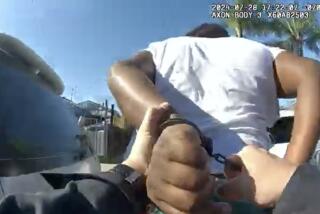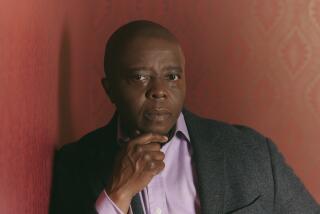Videos of individual police encounters are part of a bigger picture
A spate of videos has brought what looks like police brutality into our living rooms.
Logic says these incidents are aberrations; thatâs what makes them news. But Iâm having trouble clearing my mind of those ugly scenes â and I know Iâm not alone.
Are these just individual cops gone rogue? Or are they the tip of a giant iceberg of on-duty misconduct?
Thatâs become the subject of private small talk and public dialogue, as we grow uncomfortably accustomed to the sight of law enforcement officers meting out street justice.
This week brought criminal charges against a Los Angeles Police Department officer caught last fall on camera stomping and kicking a man being held down by other officers on a South Los Angeles street. The video from a storeâs surveillance camera hasnât been publicly released, but when the police chief pronounces it disturbing, you can imagine how bad it must be.
We did see the beating of Francis Pusok in San Bernardino County, shot by a television news helicopter this month. It shows sheriffâs deputies kicking and punching Pusok, who is on the ground with his hands behind his back.
And the cellphone video of a homeless man being shot to death during a tussle with LAPD officers on skid row.
And the pummeling of a mentally ill woman by a California Highway Patrol officer whoâd been summoned to keep her from walking onto a busy freeway. A passing motorist captured and shared the stomach-turning scene.
Just last Sunday, a federal marshal was caught on video smashing a womanâs cellphone on the ground as she recorded officers detaining several people in her South Gate neighborhood.
For me, the most painful of the flurry of police videos recorded an encounter in South Carolina, where an officer shot a man eight times in the back as he fled during a traffic stop. Then the cop placed what appeared to be his stun gun next to the dying man, and claimed that the shooting had occurred during a scuffle over the weapon.
The officerâs story would have been hard to refute had a passerby not captured the encounter on his cellphone. After the video surfaced, the officer was charged with murder.
Thatâs hardly mollifying. Iâll recall that video and that lie whenever I hear an officer explain a shooting with: âHe was reaching for my gun.â
::
I spend a lot of time lecturing readers who email to complain about something horrible that âthe blacksâ have done: Itâs wrong to judge an entire group by the actions of some. Iâm not to blame for the black guy who burglarized your house or the black woman who was rude to you at Walmart.
Yet, even though Iâve felt the sting of stereotyping, I feel like Iâm in the grip now of an insidious bias â battling a new and reflexive distrust of law enforcement.
I know thatâs unfair, yet every video peek behind the curtain seems to reinforce it.
Itâs not just the officers who administer the beatings or fire the guns that poison my perception. The ones who watch, but donât intervene, do just as much damage to our collective impression. They suggest that what weâre seeing is business as usual.
Take the case of Omar Abrego, who died last summer after struggling with a pair of officers trying to arrest him. A cellphone video captured Abregoâs suffering, but doesnât make clear whether officers went too far.
What it does show is more than a dozen patrol cars descending on the street, adding nothing but chaos to an already tense encounter. âI think we have enough, fellas,â one officer said as a half-dozen cops crouched around Abrego and others milled about.
Two dozen officers to arrest a guy for reckless driving. Itâs a scene out of sync with what we consider community policing, but itâs the reality in some neighborhoods.
âFor some people these videos provide a sort of relief,â said Sandra Hernandez of the American Civil Liberties Union of Southern California. âIt gives a certain validation to what they know is true. For years, they have been saying this goes on, and no would believe it.â
::
Technology is reshaping our perception of policing and the criminal justice system it serves. Both, it seems, are more fallible than weâd like to believe.
The omnipresence of cameras is making it harder for officers to avoid accountability. Advances in DNA matching have freed more than 300 people around the country convicted for crimes they didnât commit.
The revelations are forcing us to acknowledge that justice can be ambushed â by manufactured evidence, coercive interrogations, errors by eyewitnesses and even outright lies by those weâve armed with badges and guns.
So where do we go from here?
Beyond a focus on individual officers and high-profile offenses, and toward a deeper evaluation of how and why things go wrong.
âWe give police officers rights that we donât give any other government officials,â ACLU attorney Peter Bibring pointed out. âThey have the power to take a life based on their split-second judgment. So itâs crucial for us to understand how police are using their powers. And the video provides that understanding in a way almost nothing else does.â
Thatâs what makes these videos important â not just that they catch officers red-handed when they are doing wrong, but that they force us to talk about what we expect and what we wonât tolerate from law enforcement.
And thatâs a conversation that has to do more than fixate on blame or founder on stereotypes.
Twitter: @SandyBanksLAT
More to Read
Sign up for Essential California
The most important California stories and recommendations in your inbox every morning.
You may occasionally receive promotional content from the Los Angeles Times.











